Abstract
Previous experiments have revealed the expression of tumor necrosis factor alpha (TNF-alpha) transcripts in all murine bone marrow-derived macrophage colonies isolated from days 5 through 9 of differentiation in vitro. These results implicated a role for TNF-alpha gene expression during macrophage differentiation. Antisense oligomers to the initiation region of the TNF-alpha message were used to inhibit its expression, thus allowing the role of TNF-alpha gene expression in controlling the differentiation of macrophages to be determined. Results showed that TNF-alpha regulated the proliferation of macrophages during differentiation. Cells isolated on day 3 were exclusively vulnerable to the effects of blocking TNF-alpha gene expression, displaying a 30% increase in proliferation over control cells or sense oligomer-treated cells. Thus, in the absence of TNF-alpha gene expression, cells maintained proliferation instead of undergoing terminal differentiation. Exogenous TNF-alpha was capable of rescuing day 3 antisense-treated cells, therefore maintaining normal levels of proliferation. In contrast, blocking interleukin 1 beta gene expression by antisense oligonucleotide treatment had no effect on proliferation. Addition of exogenous recombinant murine or human TNF-alpha decreased the total cell number 25-50% regardless of whether cells were grown in medium containing colony-stimulating factor 1 (CSF-1) or granulocyte-macrophage colony-stimulating factor (GM-CSF). These results suggested that exogenous TNF-alpha suppressed proliferation of early hematopoietic progenitors, whereas endogenous TNF-alpha regulated proliferation of macrophage progenitors. The number of differentiated, adherent macrophages on day 5 of differentiation in vitro was increased by TNF-alpha treatment of GM-CSF-induced macrophages but was suppressed in CSF-1-induced macrophages. These findings suggest that distinct TNF receptor expression and/or signaling is induced in differentiating macrophages stimulated with either growth factor.
Full text
PDF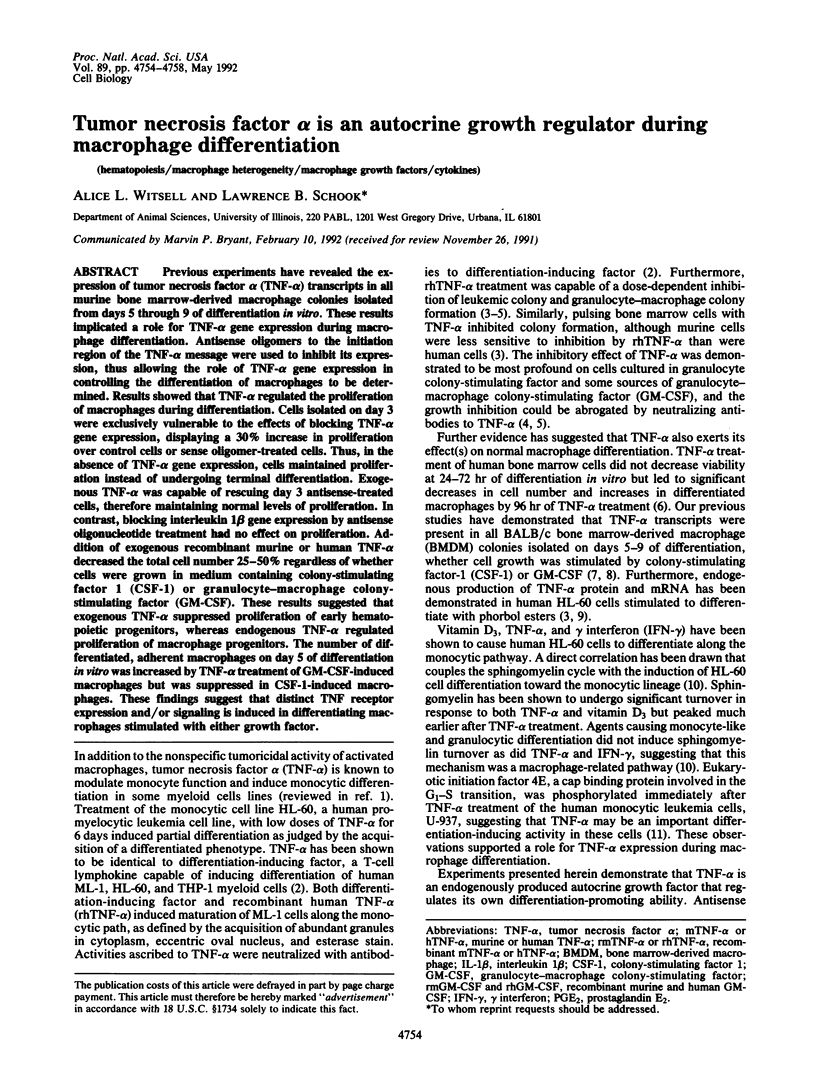
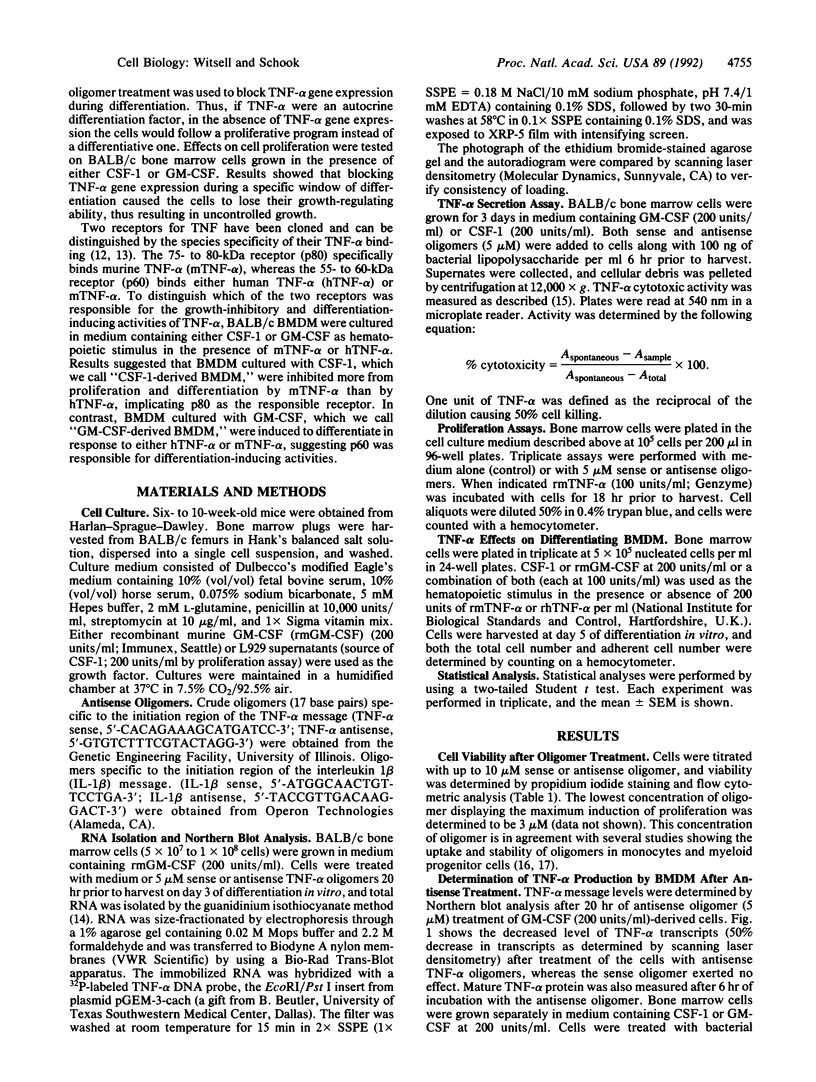
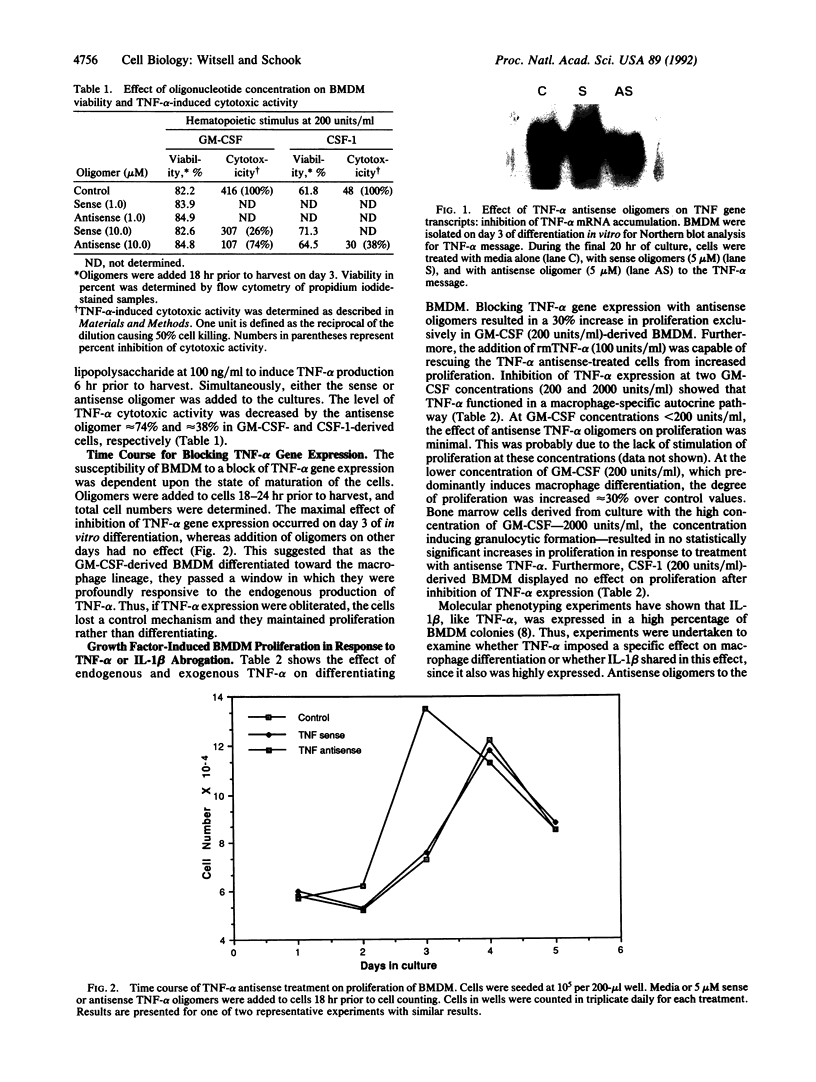
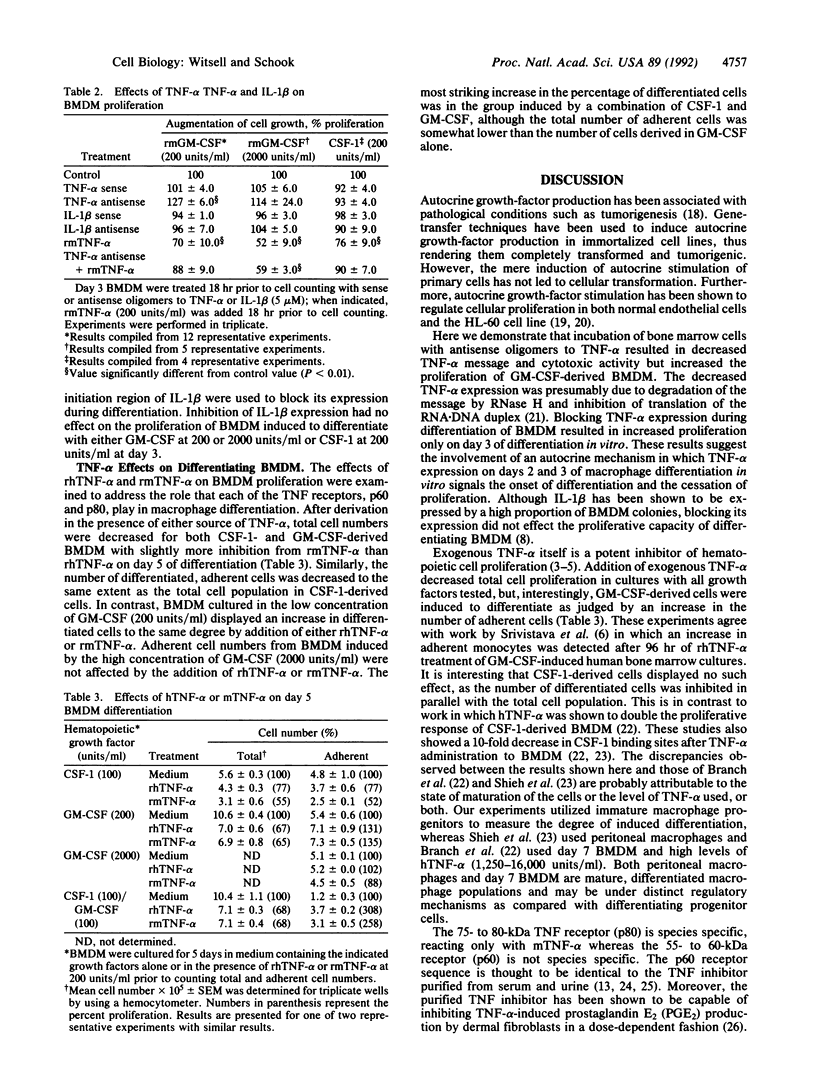
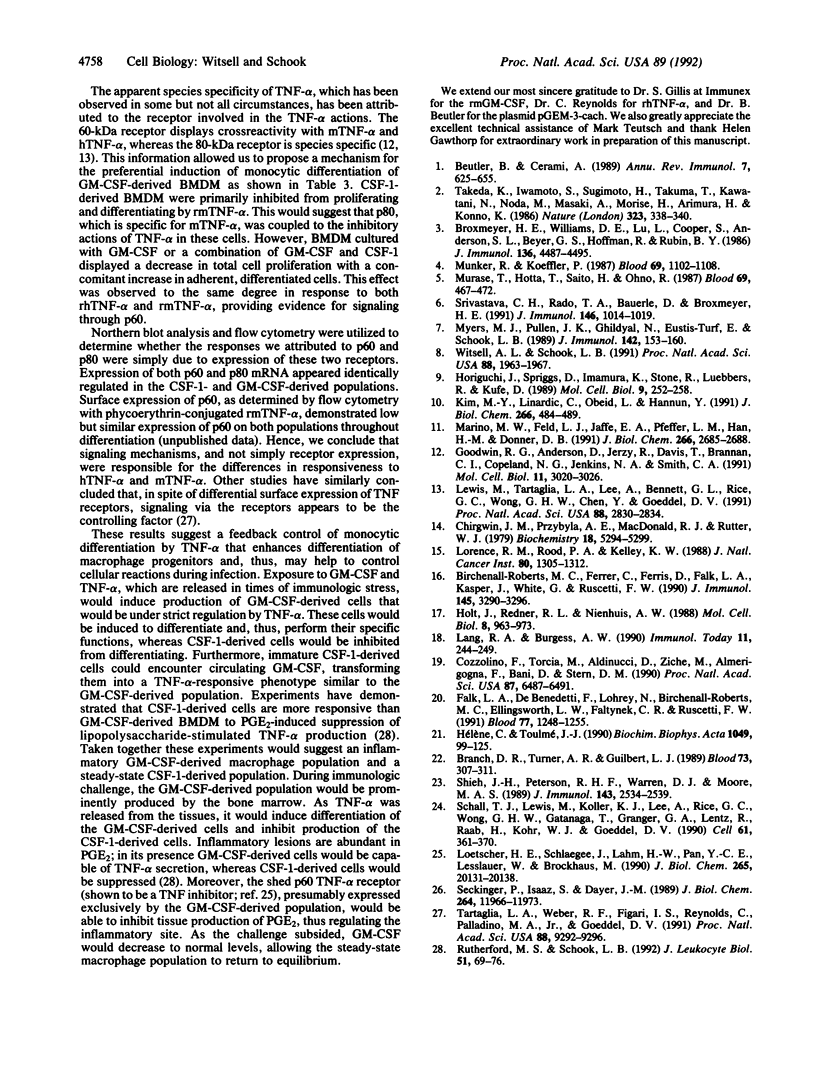
Images in this article
Selected References
These references are in PubMed. This may not be the complete list of references from this article.
- Beutler B., Cerami A. The biology of cachectin/TNF--a primary mediator of the host response. Annu Rev Immunol. 1989;7:625–655. doi: 10.1146/annurev.iy.07.040189.003205. [DOI] [PubMed] [Google Scholar]
- Birchenall-Roberts M. C., Ferrer C., Ferris D., Falk L. A., Kasper J., White G., Ruscetti F. W. Inhibition of murine monocyte proliferation by a colony-stimulating factor-1 antisense oligodeoxynucleotide. Evidence for autocrine regulation. J Immunol. 1990 Nov 15;145(10):3290–3296. [PubMed] [Google Scholar]
- Branch D. R., Turner A. R., Guilbert L. J. Synergistic stimulation of macrophage proliferation by the monokines tumor necrosis factor-alpha and colony-stimulating factor 1. Blood. 1989 Jan;73(1):307–311. [PubMed] [Google Scholar]
- Broxmeyer H. E., Williams D. E., Lu L., Cooper S., Anderson S. L., Beyer G. S., Hoffman R., Rubin B. Y. The suppressive influences of human tumor necrosis factors on bone marrow hematopoietic progenitor cells from normal donors and patients with leukemia: synergism of tumor necrosis factor and interferon-gamma. J Immunol. 1986 Jun 15;136(12):4487–4495. [PubMed] [Google Scholar]
- Chirgwin J. M., Przybyla A. E., MacDonald R. J., Rutter W. J. Isolation of biologically active ribonucleic acid from sources enriched in ribonuclease. Biochemistry. 1979 Nov 27;18(24):5294–5299. doi: 10.1021/bi00591a005. [DOI] [PubMed] [Google Scholar]
- Cozzolino F., Torcia M., Aldinucci D., Ziche M., Almerigogna F., Bani D., Stern D. M. Interleukin 1 is an autocrine regulator of human endothelial cell growth. Proc Natl Acad Sci U S A. 1990 Sep;87(17):6487–6491. doi: 10.1073/pnas.87.17.6487. [DOI] [PMC free article] [PubMed] [Google Scholar]
- Falk L. A., De Benedetti F., Lohrey N., Birchenall-Roberts M. C., Ellingsworth L. W., Faltynek C. R., Ruscetti F. W. Induction of transforming growth factor-beta 1 (TGF-beta 1), receptor expression and TGF-beta 1 protein production in retinoic acid-treated HL-60 cells: possible TGF-beta 1-mediated autocrine inhibition. Blood. 1991 Mar 15;77(6):1248–1255. [PubMed] [Google Scholar]
- Goodwin R. G., Anderson D., Jerzy R., Davis T., Brannan C. I., Copeland N. G., Jenkins N. A., Smith C. A. Molecular cloning and expression of the type 1 and type 2 murine receptors for tumor necrosis factor. Mol Cell Biol. 1991 Jun;11(6):3020–3026. doi: 10.1128/mcb.11.6.3020. [DOI] [PMC free article] [PubMed] [Google Scholar]
- Holt J. T., Redner R. L., Nienhuis A. W. An oligomer complementary to c-myc mRNA inhibits proliferation of HL-60 promyelocytic cells and induces differentiation. Mol Cell Biol. 1988 Feb;8(2):963–973. doi: 10.1128/mcb.8.2.963. [DOI] [PMC free article] [PubMed] [Google Scholar]
- Horiguchi J., Spriggs D., Imamura K., Stone R., Luebbers R., Kufe D. Role of arachidonic acid metabolism in transcriptional induction of tumor necrosis factor gene expression by phorbol ester. Mol Cell Biol. 1989 Jan;9(1):252–258. doi: 10.1128/mcb.9.1.252. [DOI] [PMC free article] [PubMed] [Google Scholar]
- Hélène C., Toulmé J. J. Specific regulation of gene expression by antisense, sense and antigene nucleic acids. Biochim Biophys Acta. 1990 Jun 21;1049(2):99–125. doi: 10.1016/0167-4781(90)90031-v. [DOI] [PubMed] [Google Scholar]
- Kim M. Y., Linardic C., Obeid L., Hannun Y. Identification of sphingomyelin turnover as an effector mechanism for the action of tumor necrosis factor alpha and gamma-interferon. Specific role in cell differentiation. J Biol Chem. 1991 Jan 5;266(1):484–489. [PubMed] [Google Scholar]
- Lang R. A., Burgess A. W. Autocrine growth factors and tumourigenic transformation. Immunol Today. 1990 Jul;11(7):244–249. doi: 10.1016/0167-5699(90)90098-t. [DOI] [PubMed] [Google Scholar]
- Lewis M., Tartaglia L. A., Lee A., Bennett G. L., Rice G. C., Wong G. H., Chen E. Y., Goeddel D. V. Cloning and expression of cDNAs for two distinct murine tumor necrosis factor receptors demonstrate one receptor is species specific. Proc Natl Acad Sci U S A. 1991 Apr 1;88(7):2830–2834. doi: 10.1073/pnas.88.7.2830. [DOI] [PMC free article] [PubMed] [Google Scholar]
- Loetscher H., Schlaeger E. J., Lahm H. W., Pan Y. C., Lesslauer W., Brockhaus M. Purification and partial amino acid sequence analysis of two distinct tumor necrosis factor receptors from HL60 cells. J Biol Chem. 1990 Nov 25;265(33):20131–20138. [PubMed] [Google Scholar]
- Lorence R. M., Rood P. A., Kelley K. W. Newcastle disease virus as an antineoplastic agent: induction of tumor necrosis factor-alpha and augmentation of its cytotoxicity. J Natl Cancer Inst. 1988 Oct 19;80(16):1305–1312. doi: 10.1093/jnci/80.16.1305. [DOI] [PubMed] [Google Scholar]
- Marino M. W., Feld L. J., Jaffe E. A., Pfeffer L. M., Han H. M., Donner D. B. Phosphorylation of the proto-oncogene product eukaryotic initiation factor 4E is a common cellular response to tumor necrosis factor. J Biol Chem. 1991 Feb 15;266(5):2685–2688. [PubMed] [Google Scholar]
- Munker R., Koeffler P. In vitro action of tumor necrosis factor on myeloid leukemia cells. Blood. 1987 Apr;69(4):1102–1108. [PubMed] [Google Scholar]
- Murase T., Hotta T., Saito H., Ohno R. Effect of recombinant human tumor necrosis factor on the colony growth of human leukemia progenitor cells and normal hematopoietic progenitor cells. Blood. 1987 Feb;69(2):467–472. [PubMed] [Google Scholar]
- Myers M. J., Pullen J. K., Ghildyal N., Eustis-Turf E., Schook L. B. Regulation of IL-1 and TNF-alpha expression during the differentiation of bone marrow derived macrophage. J Immunol. 1989 Jan 1;142(1):153–160. [PubMed] [Google Scholar]
- Rutherford M. S., Schook L. B. Differential immunocompetence of macrophages derived using macrophage or granulocyte-macrophage colony-stimulating factor. J Leukoc Biol. 1992 Jan;51(1):69–76. doi: 10.1002/jlb.51.1.69. [DOI] [PubMed] [Google Scholar]
- Schall T. J., Lewis M., Koller K. J., Lee A., Rice G. C., Wong G. H., Gatanaga T., Granger G. A., Lentz R., Raab H. Molecular cloning and expression of a receptor for human tumor necrosis factor. Cell. 1990 Apr 20;61(2):361–370. doi: 10.1016/0092-8674(90)90816-w. [DOI] [PubMed] [Google Scholar]
- Seckinger P., Isaaz S., Dayer J. M. Purification and biologic characterization of a specific tumor necrosis factor alpha inhibitor. J Biol Chem. 1989 Jul 15;264(20):11966–11973. [PubMed] [Google Scholar]
- Shieh J. H., Peterson R. H., Warren D. J., Moore M. A. Modulation of colony-stimulating factor-1 receptors on macrophages by tumor necrosis factor. J Immunol. 1989 Oct 15;143(8):2534–2539. [PubMed] [Google Scholar]
- Srivastava C. H., Rado T. A., Bauerle D., Broxmeyer H. E. Regulation of human bone marrow lactoferrin and myeloperoxidase gene expression by tumor necrosis factor-alpha. J Immunol. 1991 Feb 1;146(3):1014–1019. [PubMed] [Google Scholar]
- Takeda K., Iwamoto S., Sugimoto H., Takuma T., Kawatani N., Noda M., Masaki A., Morise H., Arimura H., Konno K. Identity of differentiation inducing factor and tumour necrosis factor. 1986 Sep 25-Oct 1Nature. 323(6086):338–340. doi: 10.1038/323338a0. [DOI] [PubMed] [Google Scholar]
- Tartaglia L. A., Weber R. F., Figari I. S., Reynolds C., Palladino M. A., Jr, Goeddel D. V. The two different receptors for tumor necrosis factor mediate distinct cellular responses. Proc Natl Acad Sci U S A. 1991 Oct 15;88(20):9292–9296. doi: 10.1073/pnas.88.20.9292. [DOI] [PMC free article] [PubMed] [Google Scholar]



